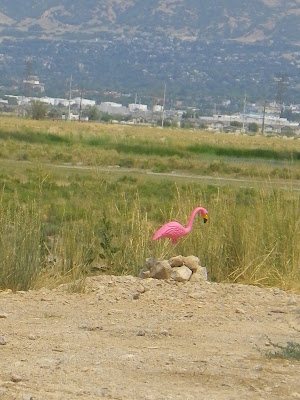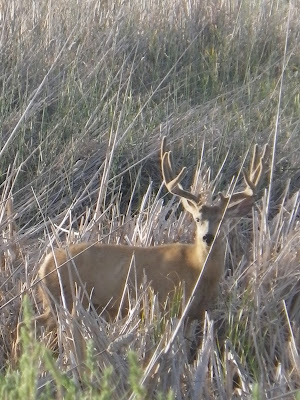Sorry for the blogging hiatus. I've been "in the field." This means that I spend 12-15 hours a day travelling, working, and cleaning up after work. The rest of my day is usually spent in search of food and trying to relax so I don't have dreams about being the field. I'm three weeks into my field season, with one to go, and up until last night I hadn't had any field dreams. I was pretty sad when I woke up this morning and remembered two points during the night where I had to sit up and remind myself that I was not out in the field, there was so no work that needed to be done, and that I needed to go back to sleep. If it seems like I pack a whole lot of work into just a few weeks of the summer, it's true, but that's the way plant-based field work goes. I need to survey the vegetation of my 50 sites within as short a period of time as possible, so that I'm surveying each site at a point where they are all comparable. It's tough work, but not as hard as the work my technicians are doing. That's right, technicians in the plural. I thought this was going to be a wicked easy year, but because there's a critical mapping component that needed to happen, I've got a crew of 3-4 (and sometime 6) that I take out four days a week. And they've been awesome.
Really, this season has gone far more smoothly than last year, but I still have a few complaints -
1. I hate wading through cow poop. There's too much cow poop in my wetlands! There are too many cows in my way. They're inconvenient and I hate them.
2. It's hot. Too hot. It's drying up all my wetlands.
3. I'm taking too much expensive equipment out into the wetlands, between the tablet, 2 lab gps units, an Archer gps unit, and the rtk GPS, there's a lot of stuff I could break/drown.
But all of these complaints have a bit of an upside
1. Only one of my piezometers has been disrupted by a cow. And by eating all day long, the cows might be opening up the canopy of some of the more invaded wetlands to allow shorter native species to come in (the juries still out on that one though).
2. When wetlands are dry the cow poop dries and I don't have to wade through it. And drought is a natural part of wetland hydroperiods (unfortunately, this might be too much drought).
3. That expensive stuff is providing some really cool data. And using my tablet makes it so I don't have to spend weeks entering all of this data (but I did really enjoy the 3 seasons of Buffy the Vampire Slayer I watched while entering my data last year).
I know it's a little early to pack it in and say Mission Accomplished, but I'm ready to post some of my favorite field work images, so here goes.
 |
| Those grey things in the water there are carp, they're a pretty big problem. They grow huge and spend their days uprooting aquatic vegetation and terrorizing me (no joke, I kicked one on Friday and screamed like a little girl). |
 |
| I hope Chaco appreciates all the foot prints I've left in the mud. I sure enjoy them. |
 |
| This is Bull thistle, but growing up we called it a Man Eating Plant, and that's what it's doing there, eating my arm, obviously. |
 |
| Here you can see a lady bug, old Phragmites that has been sprayed with herbicide, and smoke from Phragmites fires in the back ground. |
 |
| One of my favorite grasses: Hordeum jubatum or foxtail barely. I think it's pretty. |
 |
| Storms over the Promontory Mountains. I've become a little obsessed with these mountains in the past few years. Tragically, they're mostly privately owned, so you have to obtain special permission to hike to those peaks. |
 |
| Super awesome field technician, David, and his spirit animal - The Praying Mantis. |
 |
| Look closely, there's lots of damselflies hanging off the Kochia. It's the only thing Kochia is good for. |
 |
| We were out in the field during that period of the summer they were measuring precipitable water - the amount of water that could be evaporated and come down in thunderstorms. There were a lot of thunder clouds that missed us, but these one at least shaded us for some of the day. |
 |
| My cattail spear. And Frog Togg. |
 |
| Wet lands? |
 |
| I really can't complain about days like this, we got a boat ride out to our awesome sites, and there were clouds. And we never once had to push the boat out of the mud. Luck was on our side that day. |
 |
| Double crested cormorants like to hang out of rocks and trees. It's kind of an odd site, but also awesome. |
 |
| The most common marsh mammal around the Great Salt Lake. This one completely justified my fear of cows, as it still has horns and was pawing at the dirt and snorting just like aggressive cows do in the movies. |
 |
| The field vehicle was having some problems, perhaps in part due to the air filter full of grass, seeds, and entire bugs. |
 |
| The rare Great Salt Lake Flamingo. A mighty fine site for sore eyes. |
 |
| Evidence to suggest that this was once a wet wetland. |
 |
| Pelicans are pretty great, and in the mornings we get to see whole flocks of them flying overhead. |
 |
| I am very fond of mud, pickleweed, and adventures. |
 |
| Our very first rain and thunder storm! Only downside was that we were in the middle of a pond with a 5 foot long steel auger and an rtk GPS on a 6 foot pole. Don't worry, no one was hurt. |
 |
| My Wetland Warriors. And the rtk. |
 |
| Marsh Mammal #2, the noble Phragmites deer, prancing gallantly through the marsh. |
 |
| Long billed curlew, one of my favorites. They nest later in the season (around June) out of the playas, so they spent a lot of time harassing us while we installed piezometers. |
 |
| Wetland soils are the coolest. |

























No comments:
Post a Comment